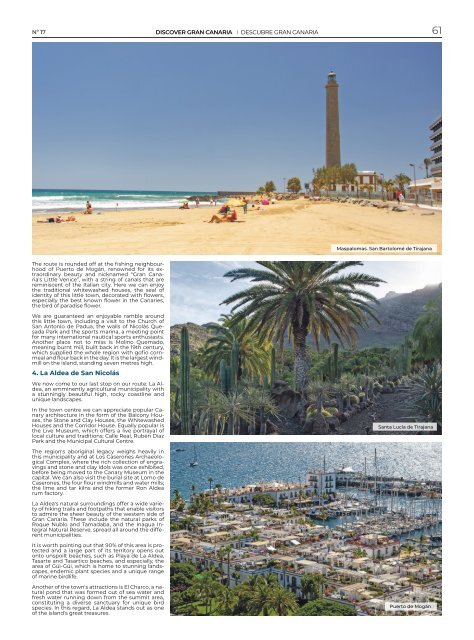No. 17 - Its Gran Canaria Magazine
Rutas, recomendaciones y noticias de Gran Canaria. Routes, tips and news about Gran Canaria.
Rutas, recomendaciones y noticias de Gran Canaria.
Routes, tips and news about Gran Canaria.
Create successful ePaper yourself
Turn your PDF publications into a flip-book with our unique Google optimized e-Paper software.
Nº <strong>17</strong> DISCOVER GRAN CANARIA I DESCUBRE GRAN CANARIA<br />
61<br />
Maspalomas. San Bartolomé de Tirajana<br />
The route is rounded off at the fishing neighbourhood<br />
of Puerto de Mogán, renowned for its extraordinary<br />
beauty and nicknamed “<strong>Gran</strong> <strong>Canaria</strong>'s<br />
Little Venice”, with a string of canals that are<br />
reminiscent of the Italian city. Here we can enjoy<br />
the traditional whitewashed houses, the seal of<br />
identity of this little town, decorated with flowers,<br />
especially the best known flower in the Canaries,<br />
the bird of paradise flower.<br />
We are guaranteed an enjoyable ramble around<br />
this little town, including a visit to the Church of<br />
San Antonio de Padua, the walls of Nicolás Quesada<br />
Park and the sports marina, a meeting point<br />
for many international nautical sports enthusiasts.<br />
Another place not to miss is Molino Quemado,<br />
meaning burnt mill, built back in the 19th century,<br />
which supplied the whole region with gofio cornmeal<br />
and flour back in the day. It is the largest windmill<br />
on the island, standing seven metres high.<br />
4. La Aldea de San Nicolás<br />
We now come to our last stop on our route: La Aldea,<br />
an emminently agricultural municipality with<br />
a stunningly beautiful high, rocky coastline and<br />
unique landscapes.<br />
In the town centre we can appreciate popular Canary<br />
architecture in the form of the Balcony Houses,<br />
the Stone and Clay Houses, the Whitewashed<br />
Houses and the Corridor House. Equally popular is<br />
the Live Museum, which offers a live portrayal of<br />
local culture and traditions; Calle Real, Rubén Díaz<br />
Park and the Municipal Cultural Centre.<br />
Santa Lucía de Tirajana<br />
The region's aboriginal legacy weighs heavily in<br />
this municipality and at Los Caserones Archaeological<br />
Complex, where the rich collection of engravings<br />
and stone and clay idols was once exhibited,<br />
before being moved to the Canary Museum in the<br />
capital. We can also visit the burial site at Lomo de<br />
Caserones, the four flour windmills and water mills;<br />
the lime and tar kilns and the former Ron Aldea<br />
rum factory.<br />
La Aldea's natural surroundings offer a wide variety<br />
of hiking trails and footpaths that enable visitors<br />
to admire the sheer beauty of the western side of<br />
<strong>Gran</strong> <strong>Canaria</strong>. These include the natural parks of<br />
Roque Nublo and Tamadaba, and the Inagua Integral<br />
Natural Reserve, spread all around the different<br />
municipalities.<br />
It is worth pointing out that 90% of this area is protected<br />
and a large part of its territory opens out<br />
onto unspoilt beaches, such as Playa de La Aldea,<br />
Tasarte and Tasartico beaches, and especially, the<br />
area of Güi-Güi, which is home to stunning landscapes,<br />
endemic plant species and a unique range<br />
of marine birdlife.<br />
Another of the town's attractions is El Charco, a natural<br />
pond that was formed out of sea water and<br />
fresh water running down from the summit area,<br />
constituting a diverse sanctuary for unique bird<br />
species. In this regard, La Aldea stands out as one<br />
of the island's great treasures.<br />
Puerto de Mogán

















